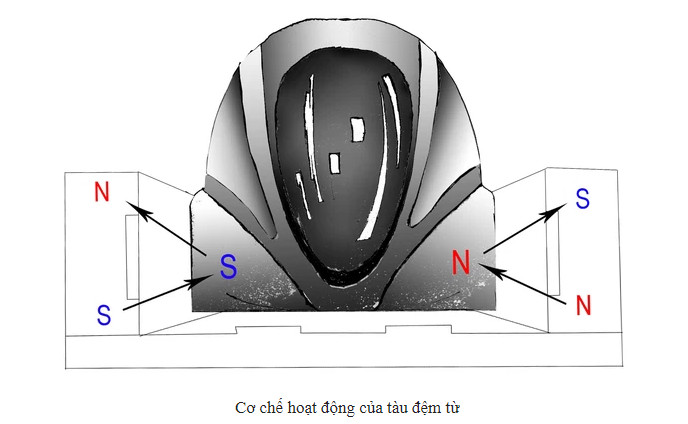Applications
HOW MAGNETS CHANGED THE WORLD?
Did you know that the little magnet – a childhood toy for many people – also has many interesting uses, contributing greatly to science and technology. With the application of magnets in scientific research, many of you will surely feel proud and surprised.
Let’s learn about modern inventions that apply magnetic force from magnets through the article below.
1. Help trains run at super-fast speeds
In early 2014, Japan broke the world speed record for trains with a type of train that can run at a speed of… 366 miles/hour (nearly 600km/h) by applying magnetic force.

This type of train completely leaves the wheel part to the magnets. The power source for operating the train is produced by superconducting magnets fixed on the body of the train and magnet coils installed on the rails. These magnets with the same poles and the North-South poles constantly changing create a pulling-pushing force, making the train glide. What is even more interesting is that this train seems to “run like flying”. Because when the train passes, the magnet coils attached to the rails mentioned above combine with the magnetic force originating from the body of the train, causing a second pulling-pushing force to be generated, lifting the train off the rails by a few centimeters.

These magical magnet coils are a “made in Japan” product, U-shaped and have the ability to prevent the train from tipping over. Thanks to that, this type of train is not only faster, “greener” but also safer and quieter than electric trains or diesel trains. Magnetic trains with speeds comparable to airplanes using propeller engines are considered a spectacular leap in the transportation industry.
This type of transportation is being cherished by major cities around the world such as Shanghai, Seoul … and in the future may appear in Vietnam.
2. Help skateboards fly in the air
Being able to glide on a hoverboard often seen in American action movies must be the dream of many people. Their dream can be said to have now come true, when recently a major technology company in the world has launched a type of skateboard that is considered “unbelievable”.
Looking like a regular skateboard, this special board can “fly” and glide about 3cm above the ground.

The secret of the Hoverboard is the 4 hidden motors inside. They are made from super electromagnets that can generate a strong enough magnetic field when interacting with each other to overcome the Earth’s magnetic field, similar to the operating mechanism of the maglev train above.
Although there are many disadvantages, this skateboard is a testament to the miraculous application of technology using magnets.
Perhaps in the near future, the image of “flying on the clouds” hoverboards will become more familiar to people around the world.
3. Developing drugs to detect cancer
The development of technology in recent years has made great strides and magnets are one of the factors contributing to those achievements. Thanks to magnets, scientists are developing a pill that can detect cancer cells in the human body.

Accordingly, the pill will contain tiny magnetic particles that can “sniff out” cancer cells early. When entering the body, the magnetic dust will immediately stick to the cell walls that have the potential to cause cancer in the blood vessels, then send the results to a device attached to the wrist.
This will help doctors detect cancer early, thereby having appropriate treatment directions, reducing the consequences for the patient.
Some people are concerned that magnets will harm the body, but according to scientists, the magnetic dust in the pill is extremely small so it will not cause any harm.
4. An indispensable component of a helmet that reduces injuries when playing sports
Not stopping at the medical field, magnets have also entered sports, appearing in this very modern protective device. Injuries in sports, such as American football, can lead to major damage to players. In 2013 in the US, there were 123 head injuries caused in this sport. Current sports helmets can only protect the skull, while the brain is still in danger. But from now on, this concern may have been temporarily put to rest.

Raymond Colello – Professor at Virginia Commonwealth University asserts that if a super-light magnet is added to the front of the current sports helmet, it can act as a “brake” system, minimizing injuries in strong head collisions.

The idea is quite simple. When two players are about to collide, the magnets attached to the two helmets will repel each other due to their similar poles, causing the two heads to “brake”, reducing the risk of brain injury.
5. Make the Road for Self-Driving Cars a Reality
The development of driverless vehicles is currently a fierce race among major technology corporations around the world. Of course, to ensure the safety of these vehicles, it is necessary to build a special highway system specifically for these “super products”. In 2013, Swedish car manufacturer Volvo announced that it had completed research on the application of a magnet system to highways.
These magnets act as a positioning system for self-driving cars, preventing them from deviating from the road and causing accidents.
More specifically, this magnet system has a huge advantage, which is that it operates absolutely accurately in any weather conditions, far surpassing its “predecessor”, the GPS positioning system.

However, installing this road system is not simple. The application of self-driving car technology in countries is certainly not likely to appear in the near future.

